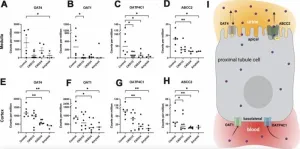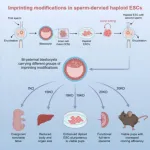(Press-News.org) The fact that the cold, dry Mars of today had flowing rivers and lakes several billion years ago has puzzled scientists for decades. Now, Harvard researchers think they have a good explanation for a warmer, wetter ancient Mars.
Building on prior theories describing the Mars of yore as a hot again, cold again place, a team led by researchers at the Harvard John A. Paulson School of Engineering and Applied Sciences (SEAS) have determined the chemical mechanisms by which ancient Mars was able to sustain enough warmth in its early days to host water, and possibly life.
“It’s been such a puzzle that there was liquid water on Mars, because Mars is further from the sun, and also, the sun was fainter early on,” said Danica Adams, NASA Sagan Postdoctoral Fellow and lead author of the new paper in Nature Geoscience.
Hydrogen was previously theorized as the magic ingredient, mixed with carbon dioxide in the Martian atmosphere to trigger episodes of greenhouse warming. But the lifetime of atmospheric hydrogen is short, so a more detailed analysis was required.
Now, Adams; Robin Wordsworth, the Gordon McKay Professor of Environmental Science and Engineering at SEAS; and team have performed photochemical modeling – similar to methods used today to track air pollutants – to fill in details of the early Martian atmosphere’s relationship to hydrogen, and how that relationship changed over time.
“Early Mars is a lost world, but it can be reconstructed in great detail if we ask the right questions,” Wordsworth said. “This study synthesizes atmospheric chemistry and climate for the first time, to make some striking new predictions – which are testable once we bring Mars rocks back to Earth.”
Adams modified a model called KINETICS to simulate how a combination of hydrogen and other gases reacting with both the ground and the air controlled the early Martian climate.
She found that during Mars’ Noachian and Hesperian periods, between 4 and 3 billion years ago, Mars experienced episodic warm spells over about 40 million years, with each event lasting 100,000 or more years. These estimates are consistent with geologic features on Mars today. The warm, wet periods were driven by crustal hydration, or water being lost to the ground, which supplied enough hydrogen to build up in the atmosphere over millions of years.
During the fluctuations between warm and cold climates, the chemistry of Mars’ atmosphere was also fluctuating. CO2 is constantly hit by sunlight and converted to CO. In warm periods, the CO could recycle back into CO2, making CO2 and hydrogen dominant. But if it was cold for long enough, the recycling would slow down, build up CO, and bring about a more reduced state, a.k.a. less oxygen. The redox states of the atmosphere thus changed dramatically over time.
“We’ve identified time scales for all of these alternations,” Adams said. “And we’ve described all the pieces in the same photochemical model.”
The modeling work lends potential new insight into conditions that supported prebiotic chemistry – the underpinnings of later life as we know it – during warm periods, and challenges for the persistence of that life during intervals of cold and oxidation. Adams and others are starting to work on finding evidence of those alternations using isotope chemical modeling, and they plan to compare those results to rocks from the upcoming Mars Sample Return mission.
Because Mars lacks plate tectonics, unlike Earth, the surface seen today is similar to that of long ago, making its history of lakes and rivers that much more intriguing. “It makes a really great case study for how planets can evolve over time,” Adams said.
Adams started the work as a Ph.D. student at California Institute of Technology, which hosts the photochemical model she used. The study was supported by NASA and Jet Propulsion Laboratory.
END
Explaining persistent hydrogen in Mars’ atmosphere
New insight into Red Planet’s hot again, cold again history
2025-01-28
ELSE PRESS RELEASES FROM THIS DATE:
Journals publish Montana State ecologist’s studies on the effects of prey depletion on populations of large African carnivores
2025-01-28
By Diana Setterberg, MSU News Service
BOZEMAN – Two recently published studies by a Montana State University ecologist reveal new findings about the relationship between population dynamics of two species of large African carnivores and the availability of their prey.
“The studies are related in a lot of ways,” said Scott Creel, lead author of a paper about the effects of prey depletion on endangered African wild dogs that was published this week in the journal Proceedings of the National Academy of Sciences, and co-lead author of another paper about the effects of poaching controls on African lion demographics that was featured ...
Journal explores dementia-related trends in high- and middle-income countries
2025-01-28
Data from nations around the world can be used to develop strategies for dementia prevention, treatment, and care, according to “Multidisciplinary Perspectives on Dementia and Related Population Health Trends,” a new supplemental issue of The Journals of Gerontology, Series A: Biological Sciences and Medical Sciences.
Alzheimer’s disease and Alzheimer’s-disease-related dementias are a set of conditions involving impaired memory and other cognitive processes that interfere with daily functioning. Worldwide, significant increases in the number of older adults living with dementia are ...
Government Chief Scientific Adviser to launch University of Bath’s new Institute for Digital Security and Behavior
2025-01-28
Professor Dame Angela McLean, Government Chief Scientific Adviser, will lead the launch of the University of Bath’s new Institute for Digital Security and Behaviour (IDSB), on Wednesday 29 January, at Bath’s Guildhall, in a keynote speech on Securing the Future.
The Institute marks a new research collaboration, bringing together behavioural and social scientists to address the risks to society posed by digital technology.
Researchers will study the fundamental causes of vulnerability to harm and the factors that can make people, organisations and societies safer and more ...
Antarctic ice sheet faces “death by a thousand cuts”
2025-01-28
Arecent study conducted by University of Florida geologists and geographers has shed new light on the effects of climate change on Antarctic ice shelves. It found that while there has been broad ice shelf loss due to warming temperatures, the frequency and size of major iceberg calving events has not changed significantly.
This study was led by Assistant Professor of Geological Sciences Emma MacKie, Ph.D., and Assistant Professor of Geography Katy Serafin, Ph.D., along with a collaborator at the Colorado School of Mines.
“Our results suggest that the primary threat ...
Massachusetts General Hospital, Matthew Perry Foundation announce Fellowship in Addiction Medicine
2025-01-28
BOSTON, MA— The Matthew Perry Foundation and Massachusetts General Hospital (MGH), a founding member of the Mass General Brigham healthcare system, today announced the establishment of the Matthew Perry Foundation Fellowship in Addiction Medicine for the 2025/2026 academic year. The fellow will join a highly competitive Addiction Medicine fellowship program, which is one of only 105 available in the United States and trains physicians who have completed an accredited residency program to become specialists and leaders in Addiction Medicine. The fellowship focuses on developing clinical expertise, leadership skills, and training ...
Study shows promise for treating core symptom of frontotemporal dementia
2025-01-28
A new study led by Western researchers found frequent treatment with intranasal oxytocin – a hormone in the brain associated with empathy – offers promise for addressing a key symptom among patients with frontotemporal dementia (FTD): Apathy.
It’s a common issue among those with FTD which affects the frontal and temporal lobes of the brain, impacting language, behaviour and decision making. Patients with FTD lose interest in hobbies and passions that previously brought them joy and, most devastatingly, become apathetic ...
Book will guide teachers and child care providers in using the Pyramid Model
2025-01-28
LAWRENCE — A new book co-edited by a researcher at the University of Kansas is a guide for early childhood education professionals to implement the Pyramid Model framework for promoting social-emotional competence in infants and young children.
According to publisher Brookes, “Unpacking the Infant–Toddler Pyramid Model: A Practical Guide for Teachers and Providers” is the first book to provide “a comprehensive, step-by-step overview of the widely used Pyramid Model Practices for infants and toddlers from birth to 3. With this accessible training guide, teachers and providers will use research-based practices to meet the unique needs of ...
Large magma bodies found beneath dormant volcanoes, surprising scientists
2025-01-28
ITHACA, N.Y. – New Cornell University led-research challenges the long-standing belief that active volcanoes have large magma bodies that are expelled during eruptions and then dissipate over time as the volcanoes become dormant.
Researchers used seismic waves to identify magma chambers beneath the surface of six volcanoes of various sizes and dormancy within the Cascade Range, which includes half of the U.S. volcanoes designated by the U.S. Geological Survey as “very high threat.” The team found that all of the volcanoes, including dormant ones, have persistent and large magma bodies.
The ...
Renal transporter genes and uremic toxins in aging cats with chronic kidney disease
2025-01-28
“Cats and humans share 90.9%, 77.8%, and 82.5% identities in OAT1, OATP4C1, and ABCC2 proteins, respectively.”
BUFFALO, NY- January 28, 2025 – A new research paper was published in Volume 16, Issue 22 of Aging (Aging-US) on December 20, 2024, titled, “Impaired renal transporter gene expression and uremic toxin excretion as aging hallmarks in cats with naturally occurring chronic kidney disease.”
This study, led by researchers Qinghong Li, James A. Holzwarth, Bethany Smith, Sonia Karaz, Mathieu Membrez, ...
First mouse with two male parents to reach adulthood
2025-01-28
A team of stem cell scientists have successfully used embryonic stem cell engineering to create a bi-paternal mouse—a mouse with two male parents—that lived until adulthood. Their results, publishing on January 28, 2025, in the Cell Press journal Cell Stem Cell, describe how targeting a particular set of genes involved in reproduction allowed the researchers to overcome previously insurmountable challenges in unisexual reproduction in mammals.
Scientists have attempted to create bi-paternal mice before, but the embryos ...
LAST 30 PRESS RELEASES:
COVID-19 leaves a lasting mark on the human brain
Scientists use ultrasound to soften and treat cancer tumors without damaging healthy tissue
Community swimming program for Black youth boosts skills, sense of belonging, study finds
Specific depressive symptoms in midlife linked to increased dementia risk
An ‘illuminating’ design sheds light on cholesterol
Who is more likely to get long COVID?
Study showcases resilience and rapid growth of “living rocks”
Naval Research Lab diver earns Office of Naval Research 2025 Sailor of the Year
New Mayo-led study establishes practical definition for rapidly progressive dementia
Fossil fuel industry’s “climate false solutions” reinforce its power and aggravate environmental injustice
Researchers reveal bias in a widely used measure of algorithm performance
Alcohol causes cancer. A study from IOCB Prague confirms damage to DNA and shows how cells defend against it
Hidden viruses in wastewater treatment may shape public health risks, study finds
Unlock the power of nature: how biomass can transform climate mitigation
Biochar reshapes hidden soil microbes that capture carbon dioxide in farmland
Reducing saturated fat intake shows mortality benefit, but only in high-risk individuals
Manta rays create mobile ecosystems, study finds
Study: Mixed results in using lipoic acid to treat progressive multiple sclerosis
Norbert Holtkamp appointed director of Fermi National Accelerator Laboratory
New agentic AI platform accelerates advanced optics design
Biologists discover neurons use physical signals — not electricity — to stabilize communication
Researchers discover that a hormone can access the brain by hitchhiking
University of Oklahoma researcher awarded funding to pursue AI-powered material design
Exploring how the visual system recovers following injury
Support for parents with infants at pediatric check-ups leads to better reading and math skills in elementary school
Kids’ behavioral health is a growing share of family health costs
Day & night: Cancer disrupts the brain’s natural rhythm
COVID-19 vaccination significantly reduces risk to pregnant women and baby
The role of vaccination in maternal and perinatal outcomes associated with COVID-19 in pregnancy
Mayo Clinic smartwatch system helps parents shorten and defuse children's severe tantrums early
[Press-News.org] Explaining persistent hydrogen in Mars’ atmosphereNew insight into Red Planet’s hot again, cold again history




